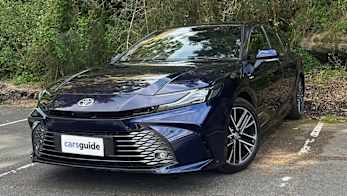Hyundai has announced that its fuel-cell powered SUV, first shown in August, will be dubbed Nexo, and that it will feature advanced driver assist technologies.
The Nexo, which was shown at this week’s Consumer Electronics Show in Las Vegas, will replace the ix35 Fuel Cell when it is rolled out globally later this year. According to Hyundai, the all-new Nexo will become “the technological flagship of Hyundai’s growing eco-vehicle portfolio”.
Making its debut in a Hyundai model will be lane-keep assist, which can adjust steering inputs while travelling from 0-145km/h to keep the vehicle in its lane.
Another feature included on the Nexo is highway driving assist, which can safely and autonomously alter speed in specific situations through the use of sensors and map data.
In a first for the industry, the Nexo will come with blind-spot view monitor, which projects camera views of the rear and side of the vehicle onto the digital instrument cluster when changing lanes in either direction. The driver will be able to see areas of the vehicle not usually possible through the use of a wide-angle surround-view camera on both sides of the vehicle.
If the technology sounds familiar, it is because many Honda vehicles are equipped with a similar feature called LaneWatch, however Honda’s version only works on the passenger side of the vehicle, and it shows up in the centre screen rather than the instrument cluster.
It will also feature remote smart parking assist that allows the Nexo to autonomously enter or exit a parking space without a passenger in the vehicle and back itself into parking spaces.
As revealed in August, the Nexo will feature a claimed 800 kilometres of driving range, 216km more than the ix35.
Power is also up from 100kW/300Nm to 120kW/394Nm, which cuts the zero to 100km/h time from 12.5 seconds to 9.5sec.
While extreme weather can be a stumbling block for fuel-cell-powered vehicles, the Nexo is capable of starting within 30 seconds after being exposed to temperatures of -29 degrees Celsius, and can cool itself when temperatures exceed 40 degrees Celsius.
Built on a dedicated vehicle architecture, it measures 4671mm long, 1859mm wide and 1631mm tall, making it 262mm longer, 38mm wider and 25mm shorter than the ix35 Fuel Cell.
In 2016, Hyundai Motor Company Australia (HMCA) inked a deal with the ACT government to supply 20 examples of the Nexo as part of the Hornsdale Wind Farm project.
Due to kick off early in 2019, the initiative will also include the construction of a wind farm capable of producing energy for up to 1000 fuel-cell electric vehicles (FCEVs) a year.
Hydrogen refuelling infrastructure is currently spartan in Australia, with only one station based at HMCA’s headquarters in Macquarie Park, Sydney, which was built for the single imported ix35 Fuel Cell.





.jpg)

.jpg)

.jpg)

.jpg)
.jpg)

.jpg)










.jpg)

_0.jpg)








.jpg)